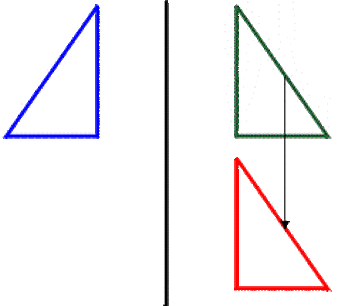
Whenever you transform a geometric figure so that the relative distance between any two points has not changed, that transformation is called an isometry. But the location of the ants relative to each other has not. The location of the ants will change relative to the plane (because they are on the triangle and the triangle has moved). Imagine two ants sitting on a triangle while you move it from one location to another. Glide reflection is common in Conway's Game of Life when producing Gun (cellular automaton).The word isometry is used to describe the process of moving a geometric object from one place to another without changing its size or shape. It can also be seen in many extant groups of sea pens. Glide symmetry can be observed in nature among certain fossils of the Ediacara biota the machaeridians and certain palaeoscolecid worms. Wallpaper group lattice domains, and fundamental domains (yellow) (Glide reflections are shown below as dashed lines) cm has parallel mirrors and glides, and pg has parallel glides. p2gg has orthogonal glide reflections and 2-fold rotations. In the Euclidean plane 3 of 17 wallpaper groups require glide reflection generators. It is a reflection in a plane combined with a translation parallel to the plane. In 3D the glide reflection is called a glide plane. With additional symmetry it occurs also in cmm, p3m1, p31m, p4m and p6m. The translational symmetry is given by oblique translation vectors from one point on a true reflection line to two points on the next, supporting a rhombus with the true reflection line as one of the diagonals. A glide reflection line parallel to a true reflection line already implies this situation. If there are also true reflection lines in the same direction then they are evenly spaced between the glide reflection lines. This corresponds to wallpaper group pg with additional symmetry it occurs also in pmg, pgg and p4g. Glide reflection symmetry with respect to two parallel lines with the same translation implies that there is also translational symmetry in the direction perpendicular to these lines, with a translation distance which is twice the distance between glide reflection lines. If the translation vector of a glide reflection is itself an element of the translation group, then the corresponding glide reflection symmetry reduces to a combination of reflection symmetry and translational symmetry. It is isomorphic to a semi-direct product of Z and C 2.Ī typical example of glide reflection in everyday life would be the track of footprints left in the sand by a person walking on a beach.įor any symmetry group containing some glide reflection symmetry, the translation vector of any glide reflection is one half of an element of the translation group. 6 (glide-reflections, translations and rotations) is generated by a glide reflection and a rotation about a point on the line of reflection. If that is all it contains, this type is frieze group p11g.Įxample pattern with this symmetry group:įrieze group nr.




In the case of glide reflection symmetry, the symmetry group of an object contains a glide reflection, and hence the group generated by it. Ĭombining two equal glide reflections gives a pure translation with a translation vector that is twice that of the glide reflection, so the even powers of the glide reflection form a translation group. The isometry group generated by just a glide reflection is an infinite cyclic group. This isometry maps the x-axis to itself any other line which is parallel to the x-axis gets reflected in the x-axis, so this system of parallel lines is left invariant. It can also be given a Schoenflies notation as S 2∞, Coxeter notation as, and orbifold notation as ∞×. A glide reflection can be seen as a limiting rotoreflection, where the rotation becomes a translation. In group theory, the glide plane is classified as a type of opposite isometry of the Euclidean plane.Ī single glide is represented as frieze group p11g. The intermediate step between reflection and translation can look different from the starting configuration, so objects with glide symmetry are in general, not symmetrical under reflection alone. In 2-dimensional geometry, a glide reflection (or transflection) is a symmetry operation that consists of a reflection over a line and then translation along that line, combined into a single operation. Since this footprint trail has glide reflection symmetry, applying the operation of glide reflection will map each left footprint into a right footprint and each right footprint to a left footprint, leading to a final configuration which is indistinguishable from the original.


 0 kommentar(er)
0 kommentar(er)
